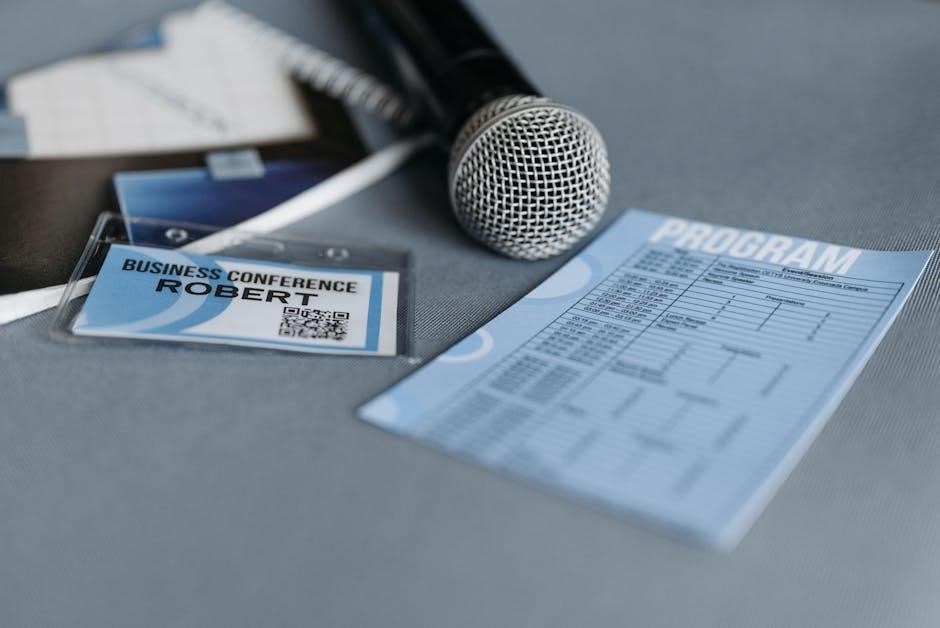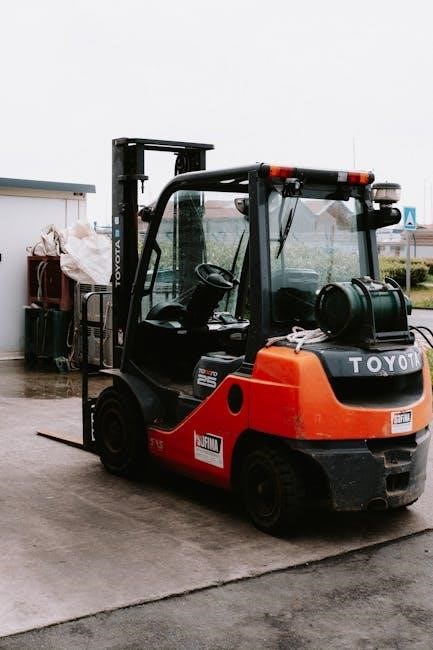Regular maintenance is essential for the Toyota Venza to ensure reliability, performance, and longevity. This guide provides a detailed schedule and tips to help owners keep their vehicle in optimal condition.
1.1 Importance of Regular Maintenance
Regular maintenance is crucial for the Toyota Venza to ensure optimal performance, reliability, and longevity. Neglecting routine checks can lead to mechanical issues, reduced fuel efficiency, and safety risks. By following the recommended maintenance schedule, owners can prevent unexpected repairs, such as premature wear on control arms or other components. Regular maintenance also enhances safety by ensuring brakes, tires, and suspension systems function properly. Additionally, it helps maintain the vehicle’s value over time. Simple tasks like oil changes, tire rotations, and fluid checks can significantly extend the life of the engine and other critical systems. Consistency in maintenance ensures the Venza runs smoothly, providing a reliable and enjoyable driving experience for years to come.
1.2 Overview of Toyota Venza Maintenance Schedule
The Toyota Venza maintenance schedule is designed to ensure the vehicle runs efficiently and reliably throughout its lifespan. It is structured around specific mileage intervals, with recommended services tailored to address potential wear and tear. Routine checks include oil changes, tire rotations, and inspections of critical systems like brakes and belts. The schedule begins with minor services at 5,000 to 7,500 miles, progressing to more comprehensive checks at 15,000, 30,000, and 60,000 miles. Major services, such as timing belt replacements and battery checks, are typically required at higher mileage intervals, like 90,000 and 120,000 miles. By following this schedule, owners can prevent costly repairs, maintain performance, and ensure safety on the road. Adhering to these guidelines helps extend the vehicle’s lifespan and keeps it operating at peak condition.

Toyota Venza Maintenance Schedule by Mileage
The Toyota Venza maintenance schedule outlines essential services at specific mileage intervals to ensure optimal performance, safety, and longevity. Regular checks include oil changes, tire rotations, and inspections.
2.1 Maintenance Requirements at 5,000 to 7,500 Miles
At 5,000 to 7,500 miles, the Toyota Venza requires routine maintenance to ensure optimal performance. This interval typically includes an oil change, tire rotation, and a thorough inspection of the vehicle. The oil change involves replacing the engine oil and filter to maintain engine health. Tire rotation is essential for even tread wear and improved safety. Inspections focus on brakes, belts, fluids, and battery condition. Additionally, the air filter may be checked and replaced if necessary. Adhering to this schedule helps prevent potential issues and ensures the vehicle runs smoothly. It’s also a good opportunity to address any minor concerns before they become major problems. Regular maintenance at this stage is crucial for extending the lifespan of your Toyota Venza and maintaining its reliability on the road.
2.2 Maintenance Requirements at 15,000 Miles
At 15,000 miles, the Toyota Venza requires more comprehensive maintenance to ensure continued performance and reliability. This interval typically includes an oil and filter change, tire rotation, and a detailed inspection of the vehicle. The inspection covers essential components such as brakes, belts, hoses, and suspension. Fluid levels, including engine oil, coolant, transmission, and brake fluid, are checked and topped off as needed. Additionally, the air filter is inspected and replaced if dirty, and the wiper blades are checked for wear. The battery is also tested for charge and connections are cleaned. This maintenance helps identify and address potential issues early, ensuring the vehicle runs smoothly and efficiently. Regular upkeep at this stage is vital for maintaining the Venza’s longevity and preventing costly repairs down the road.
2.3 Maintenance Requirements at 30,000 Miles
At 30,000 miles, the Toyota Venza requires more in-depth maintenance to ensure optimal performance and prevent potential issues. This service includes an oil and filter change, tire rotation, and a thorough inspection of the vehicle. Spark plugs are typically replaced at this interval to maintain proper engine performance. The cabin air filter is also replaced to improve air quality inside the vehicle. Brake fluid is usually replaced to ensure reliable braking performance. Additionally, the transmission fluid and coolant levels are checked and topped off if necessary. The drive belts are inspected for cracks or wear, and the tires are rotated to ensure even tread wear. This maintenance milestone is crucial for maintaining the Venza’s reliability and addressing any emerging issues before they escalate. Regular servicing at this stage helps prolong the vehicle’s lifespan and ensures smooth operation.
2.4 Maintenance Requirements at 60,000 Miles
At 60,000 miles, the Toyota Venza requires more extensive maintenance to ensure continued reliability and performance. This service typically includes replacing the timing belt and water pump, as failure of these components can lead to costly engine damage. The air filter and cabin air filter are also replaced to maintain proper airflow and interior air quality. Brake pads and rotors are inspected and replaced if worn, and the exhaust system is checked for leaks or damage. Additionally, the vehicle undergoes a thorough inspection, including tire condition, battery health, and fluid levels. This milestone is critical for addressing wear-and-tear issues and preventing potential breakdowns. Regular servicing at this stage ensures the Venza continues to operate smoothly and efficiently for years to come. Proper maintenance at this interval is vital for long-term vehicle reliability and safety.

2.5 Maintenance Requirements at 90,000 Miles
At 90,000 miles, the Toyota Venza requires a comprehensive maintenance service to address wear and tear. This includes replacing the spark plugs to ensure proper engine performance and fuel efficiency. The drive belts are also inspected and replaced if showing signs of cracking or wear. Fluid replacements are critical at this stage, with the transmission fluid, differential fluid, and transfer case fluid being changed to maintain smooth drivetrain operation. Brake pads and rotors are inspected and replaced if necessary, and the brake system is checked for leaks or damage. Additionally, the exhaust system is evaluated for leaks or corrosion, and the suspension components are inspected for wear. A thorough vehicle inspection is performed to identify any emerging issues. Proper maintenance at this milestone ensures the Venza continues to run reliably and efficiently, preventing costly repairs and extending its lifespan. Regular servicing at this interval is essential for maintaining peak performance and safety.

2.6 Maintenance Requirements at 120,000 Miles
At 120,000 miles, the Toyota Venza requires a detailed service to address high-mileage wear. The timing belt should be replaced to prevent engine damage, and the water pump is often replaced at the same time if showing signs of wear. The engine coolant is typically flushed and replaced to prevent corrosion and maintain proper cooling system function. Transmission fluid and differential fluid are changed to ensure smooth drivetrain operation. Brake pads and rotors are inspected and replaced if worn beyond safe limits. The suspension system, including control arms and bushings, is evaluated for wear and replaced if necessary. The exhaust system is checked for leaks or damage, and a detailed inspection of belts, hoses, and other components is performed to identify potential issues. Regular maintenance at this stage is crucial for ensuring the vehicle remains reliable and efficient, avoiding costly repairs down the road.

2.7 Maintenance Requirements at 150,000 Miles
At 150,000 miles, the Toyota Venza requires comprehensive maintenance to maintain its performance and longevity. Spark plugs should be replaced to ensure proper engine ignition and fuel efficiency. The ignition coils are also inspected and replaced if necessary to prevent misfires. The engine air filter and cabin air filter are replaced to improve airflow and interior air quality. The fuel injection system is cleaned to remove deposits and maintain optimal fuel flow. The PCV valve is checked and replaced if clogged to prevent oil leaks and emissions issues. The serpentine belt is inspected for cracks or wear and replaced if necessary to avoid breakdowns. Brake fluid, coolant, and transmission fluid are changed to ensure proper lubrication and cooling. The exhaust system is checked for leaks or damage, and any corroded components are replaced. Finally, the suspension system is evaluated for excessive wear, and components like shocks or struts are replaced if needed to maintain ride comfort and stability.
Additional Maintenance Considerations
Regular tire rotations, brake inspections, and fluid checks are essential. Ensure proper tire pressure and tread depth for safety and efficiency. Inspect brakes for wear and replace pads or rotors as needed.

3.1 Tire Maintenance and Rotation Schedule
Proper tire maintenance is crucial for safety and performance. Check tire pressure monthly or before long trips, ensuring it matches the recommended levels in the owner’s manual. Rotate tires every 5,000 to 7,500 miles to ensure even tread wear and extend their lifespan. Inspect tread depth regularly, replacing tires when it reaches 1/16 of an inch. Look for signs of uneven wear, which may indicate misalignment or other issues. Balance tires every 12,000 miles to maintain smooth driving and prevent excessive wear. Always use the same type and size of tires as specified by Toyota to ensure compatibility and safety. Refer to the owner’s manual for specific recommendations and consult a professional if you notice any unusual vibrations or handling issues while driving.
3.2 Brake System Maintenance and Inspection
Regular brake system maintenance is vital for safety and performance. Inspect brake pads every 10,000 to 15,000 miles and replace them when worn below 1/8 inch. Check rotors for excessive wear or warping and resurface or replace them as needed. Brake fluid should be tested for moisture and contamination every 30,000 miles, with full replacement recommended every 60,000 miles. Inspect brake lines and hoses for cracks or leaks annually. Look for signs of brake system issues, such as a spongy pedal, unusual noises, or vibrations during braking. Address any problems promptly to avoid costly repairs. Always follow Toyota’s recommended maintenance schedule and consult a professional if unsure about any aspect of brake system care. Properly maintained brakes ensure reliable stopping power and safety on the road.

3.3 Fluid Check and Replacement Guidelines
Regular fluid checks are essential to maintain the Toyota Venza’s performance and longevity. Engine oil should be changed every 5,000 to 7,500 miles, depending on driving conditions. Coolant should be inspected every 30,000 miles and replaced every 60,000 to 100,000 miles to prevent corrosion and overheating. Transmission fluid should be checked every 15,000 to 30,000 miles and replaced every 60,000 to 90,000 miles for smooth gear operation. Brake fluid should be tested for moisture every 30,000 miles and replaced every 60,000 miles to ensure reliable braking. Power steering fluid and windshield washer fluid should also be monitored and refilled as needed. Always use Toyota-approved fluids to maintain warranty and performance. Neglecting fluid maintenance can lead to engine damage, overheating, or system failures. Consult your owner’s manual or a certified technician for precise schedules and recommendations.
3.4 Belt Replacement Schedule (Serious and Drive Belts)
Regular inspection and replacement of belts are critical to prevent engine damage and ensure smooth operation. The serpentine belt, which powers essential systems like the alternator and water pump, should be inspected every 15,000 miles and replaced at 60,000 to 90,000 miles or if signs of wear appear. The timing belt, a critical component for engine synchronization, typically needs replacement at 60,000 to 105,000 miles, depending on the model year. Drive belts, such as the alternator or air conditioning belt, should be checked every 15,000 miles and replaced at 45,000 to 60,000 miles. Cracks, frays, or excessive wear indicate the need for immediate replacement. Neglecting belt maintenance can lead to costly repairs, such as engine damage or system failures. Always consult the owner’s manual or a certified technician for precise replacement intervals and recommendations.
3.5 Battery Maintenance and Replacement
Proper battery maintenance is essential to ensure reliable starting and electrical system performance in your Toyota Venza. Regularly inspect the battery terminals for corrosion or looseness, and clean them with a wire brush if necessary. Check the battery case for cracks or swelling, which may indicate a failing battery. Toyota recommends testing the battery every 3 to 5 years, especially in extreme climates, to assess its health. Replace the battery every 5 to 7 years, or when testing reveals a significant drop in performance. Always use a Toyota-approved or high-quality replacement battery to maintain performance and warranty validity. When replacing the battery, disconnect the negative terminal first to prevent electrical damage. After installation, reset the electronic systems, such as the clock and radio, and let the vehicle run for a few minutes to recalibrate the battery management system.

Common Issues and Solutions
Common Toyota Venza issues include worn control arms and premature battery degradation. Timely replacements and regular inspections can prevent costly repairs and ensure smooth vehicle operation.
4.1 Common Toyota Venza Maintenance Mistakes to Avoid
One of the most common mistakes Toyota Venza owners make is neglecting regular tire rotations, which can lead to uneven tread wear and reduced fuel efficiency. Another error is ignoring fluid checks, especially the transmission and coolant fluids, which are critical for preventing overheating and transmission failure. Many owners also overlook the importance of timely belt replacements, such as the serpentine belt, which can cause costly engine damage if it breaks. Additionally, failing to address worn brake pads early can lead to more expensive repairs, such as rotor replacement. Lastly, some owners skip recommended mileage-based maintenance, which can result in premature wear on critical components like control arms and bushings. Staying proactive with these areas ensures long-term reliability and performance.
4.2 Solutions for Common Maintenance-Related Problems
- Address uneven tire wear by adhering to the recommended tire rotation schedule (every 5,000 to 7,500 miles) to ensure even tread wear and improved handling.
- Prevent overheating by checking coolant levels regularly and flushing the system every 30,000 miles to maintain proper engine temperature regulation.
- Inspect and replace the serpentine belt at the recommended interval (typically around 90,000 miles) to avoid sudden breakdowns and costly engine damage.
- Monitor brake pad thickness and replace them when worn below 3/32″ to prevent rotor damage and ensure safe stopping power.
- Stay on top of control arm inspections, especially after 60,000 miles, and replace bushings promptly to maintain suspension integrity and ride quality.
By addressing these issues proactively, Toyota Venza owners can avoid major repairs and ensure their vehicle runs smoothly for years to come.
DIY Maintenance Tips
Regular oil changes, air filter inspections, and battery checks are simple DIY tasks for Toyota Venza owners to maintain their vehicle’s health and performance effectively.
5.1 Simple DIY Maintenance Tasks for Toyota Venza Owners
Toyota Venza owners can perform several simple DIY maintenance tasks to keep their vehicle in top shape. Regular oil changes are essential and can be done at home with the correct materials. Checking and replacing the air filter is another straightforward task that improves fuel efficiency; Tire pressure checks and rotations are also DIY-friendly, ensuring even wear and better handling. Battery maintenance, such as cleaning terminals and checking fluid levels, can prevent unexpected issues. Additionally, inspecting and replacing windshield wipers when worn is a quick fix for clear visibility. These tasks not only save money but also help owners stay connected to their vehicle’s health. Always consult the owner’s manual or online guides for specific instructions tailored to the Toyota Venza.
5.2 Tools and Resources Needed for DIY Maintenance

Performing DIY maintenance on your Toyota Venza requires the right tools and resources. Essential tools include a socket set, wrenches, an oil drain pan, and a multimeter for electrical checks. A tire pressure gauge and wheel chocks are also necessary for tire-related tasks. For fluid changes, a drain pan and new filters are must-haves. Additionally, a reliable torque wrench ensures proper bolt tightening. Online resources like repair manuals, YouTube tutorials, and forums can guide you through specific procedures. The owner’s manual is a crucial reference for scheduled maintenance and part locations. For advanced tasks, consider investing in a scan tool for diagnostics. Always use high-quality materials to ensure longevity and safety. By having the right tools and resources, you can confidently tackle DIY maintenance and keep your Toyota Venza running smoothly.

Adhering to the Toyota Venza maintenance schedule ensures long-term reliability and performance. Regular care extends the vehicle’s lifespan, while DIY tasks and professional checks keep it running smoothly and safely.
6;1 Summary of Toyota Venza Maintenance Best Practices
Consistent adherence to the Toyota Venza maintenance schedule is crucial for preserving its performance and longevity. Regular oil changes, tire rotations, and fluid checks are foundational; Inspecting brakes, belts, and batteries ensures safety and reliability. Following the recommended mileage-based tasks, such as replacing components at 30,000 and 60,000 miles, prevents premature wear. DIY maintenance, like checking air filters and wiper blades, complements professional services. Staying proactive with tire pressure, alignment, and suspension inspections enhances fuel efficiency and handling. Addressing common issues promptly avoids costly repairs. Utilizing genuine Toyota parts and approved fluids maintains warranty integrity. By combining professional care with DIY diligence, owners can maximize their Venza’s lifespan and ensure trouble-free driving for years.
6.2 Final Tips for Long-Term Vehicle Reliability
For long-term reliability, consistently follow the Toyota Venza maintenance schedule and address issues promptly. Keep the vehicle clean, as dirt and debris can damage paint and components. Regularly inspect for signs of wear, such as unusual noises or vibrations. Avoid extreme temperatures and driving conditions when possible. Use genuine Toyota parts and approved fluids to maintain performance. Schedule annual inspections with a certified mechanic to identify potential issues early. Maintain proper tire pressure and alignment for optimal fuel efficiency and handling. Avoid neglecting minor repairs, as they can lead to costly problems over time. By combining proactive care with a disciplined maintenance routine, you can ensure your Toyota Venza remains reliable and performs at its best for many years.
